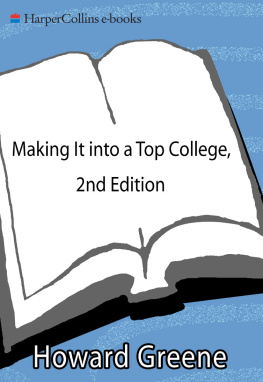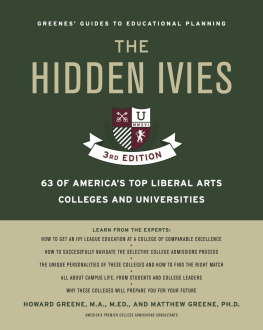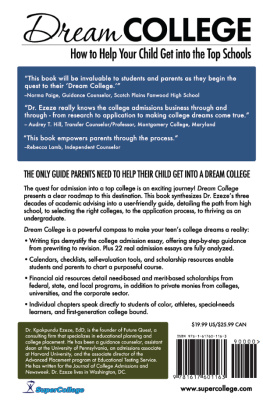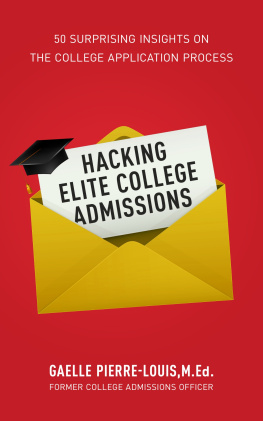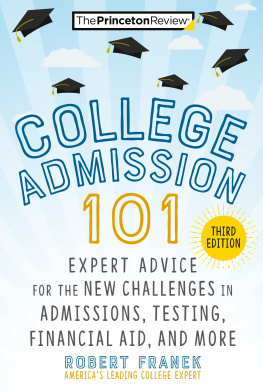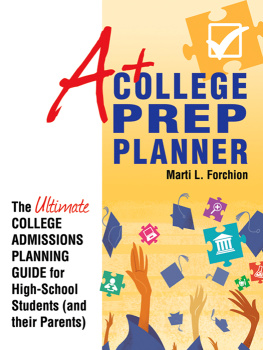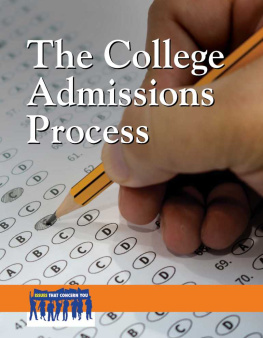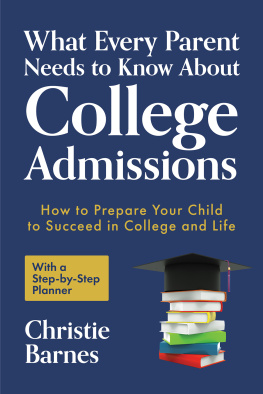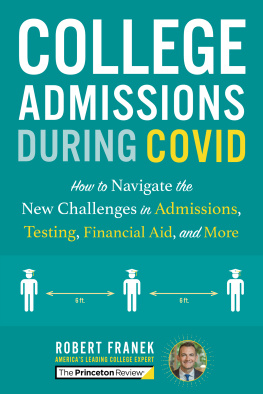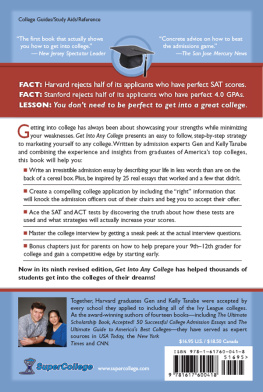We wrote our first book on planning for college admissions, and the sequence of steps that leads to successful admissions to selective colleges, in 1974. We have revised subsequent editions on the subject since then in order to keep the reader up to date on changes in admissions practices, testing, and requirements. This latest edition incorporates a number of these changes while adhering to the Ten Steps to College Admission, which have proven valuable to countless numbers of students. Over the years, we have witnessed monumental shifts in our social, economic, political, and international circumstances. Americas educational system, from top to bottom, has reflected these changes. In the intervening years we have written additional books on the admissions process at the college and graduate levels, and on the experiences of students who have made it into the elite colleges and universities. In advising thousands of students for over forty years, we continue to find that the admissions process is both a science and an art. Those who have followed the ten steps described in detail here have achieved their goal of enrolling in a top college. At the same time, there are intangible, intuitive elements to the process that you must pay attention to as you move from step to step. Personal emotions, needs, and valuesnot just academic and physical features of a collegewill play a significant role in your choosing the right college for you and completing the steps to influence the outcome.
It is time, once again, for us to assist ambitious, talented students like you who have set their sights on the top colleges by alerting you to the major changes occurring within these schools and how these are altering the admissions process today. The introductory chapter describes the major trends in our society which have directly affected our colleges and universities and what preparation is necessary for gaining acceptance to a selective institution. All of the key factors are discussed here, from the increasing competition due to more students graduating from high school and going on to college, to the rise in non-traditional students, the spiraling tuition costs and changes in financing an education, the marketing and recruiting by the colleges, the political and social tone of campuses, the technological revolution and its impact on the admission process and learning, the federal mandates that affect admission for learning disabled and physically challenged students, affirmative action for the socially and economically disadvantaged, safety on campus, and the role of athletic recruiting and community service in admissions.
Current Trends in College Admissions
As we write this at the beginning of 2009, a number of key trends continue to develop which we would like to mention briefly here. You will see that we explore them in more depth throughout the book. As we completely overhauled this version of Making It into a Top College , we were pleased to see that many of the trends that remain important today were discussed ten years ago in our first edition. We also remain firm in our belief that adhering to the principles and practices we outline in our Ten Steps is the surest way to ride out these trends successfully during the college admissions process.
- Uncertainty and unpredictability have increased. The only sure thing about selective college admissions today is the lack of surety. As applicants and applications have risen, odds of admission have decreased, and applicants must be more careful than ever to balance their college lists appropriately, prepare themselves academically to the best of their abilities, and present themselves in an outstanding manner.
- The number of college-bound high school graduates is not going to decrease significantly in the coming decades. The number of high school graduates has increased from 2.5 million in 1996 to 3.3 million in 2008, according to the College Board and the Western Interstate Commission for Higher Education (WICHE). Over the next fifteen years, the number stays between 3 and 3.5 million. There is not going to be a precipitous drop in high school graduates, and college applicants, any time soon. The numbers will plateau over the next few years, but not decrease to the lows experienced during the early 1980s. There will be a diversification of the college applicant pool, with so-called non-traditional applicants, students of color, and first-generation college applicants becoming a larger percentage of the college pool.
- Aggressive marketing and sophisticated enrollment-management efforts begun by the colleges to counter lower applicant pools two decades ago not only have not abated but have increased and intensified. These tactics have been facilitated by computer programs and the Internet. Selective colleges will continue to strive for a national applicant pool, to counteract the tendency of most high school students to attend college within a few hundred miles of home. Public universities will continue to ramp up requirements in order to reduce campus growth while enrolling those interested and qualified from within their state and from other states and abroad.
- Interest in U.S. colleges and universities among international students will continue to grow. More international students, especially from India and China and other developing countries with more students able to afford an American education, will continue to apply. These students are and will be qualified and focused, challenging the best and brightest, let alone the average American high school graduate. And that graduate will need the advantages of a higher educational degree in the increasingly knowledge-based economy of the future. For those who havent read Thomas Friedmans most recent (2007) edition of The World Is Flat , we encourage you to tackle its section on education and the competition our young people will face as they move into the global working world.
- The cost of a public or private education has risen tremendously. College cost increases have far outpaced the rate of inflation, and today the cost of a public or private university education comprises a much higher proportion of a familys income. The share of an average four-year degree covered by the need-based Pell Grant program has decreased markedly. Student loan debt has ballooned, with the average debt of a four-year-degree recipient climbing above $20,000. Apocryphal stories abound of students (and parents) borrowing $50,000, $80,000, $100,000, or more to pay for an elite private college education, scaring many families away from college, even though this is not the norm. Yet private lenders now represent the fastest-growing sector of the student loan market. With the recent chaos in the loan industry, student lending quickly followed the home lending market into a period of upheaval. Even colleges like Dartmouth, Harvard, Cornell, and Brown are sending signals of some bear market years to come, accompanied by hiring freezes, delays in campus construction projects, and challenges to their financial aid budgets. Still, stories of families inability to borrow have been largely overplayed, in our opinion. There is still a lot of money available to help families afford college, in the form of federal and state need-based assistance (loans and grants) and need-based grants from colleges, including those like Princeton, North Carolina, and Amherst, which have increased the grant-aid and decreased or eliminated the loan debt of all or many of their aid recipients. Merit-based financial awards, or discounts, have also grown rapidly, so that academically talented students, if they are smart and apply to a broad range of public and private institutions near and far from home, can open up significant savings opportunities. Many colleges offer students in the top third or even fortieth percentile of that college applicant pool merit-based scholarships.

